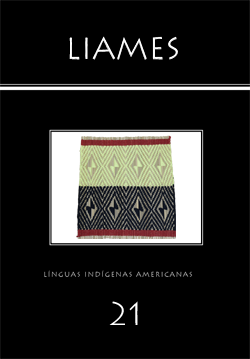Abstract
The paper investigates the count-mass distinction in Rikbaktsa (Macro-Jê). It presents the results of data collected following Lima and Rothstein’s questionnaire (2020). The data was gathered using an unpublished corpus, the scarce literature on this language (Boswood 1971, 1978; SIL 2007; Silva 2011), and elicitation with a native speaker. The analysis shows that there is plural morphology which does not combine with mass nouns. Nouns that denote stable atoms combine directly with numerals. Substance nouns require measure phrases to be counted. These are indications that this language can be classified as a number marking language (Chierchia 2010, 2015), even if there are some mass nouns that combine directly with numerals. None of the fifteen languages in Lima & Rothstein (2020) are reported to have a specialized mass morpheme. Chacon (2012) claims that Kubeo (Tukano-Oriental) has a demonstrative for mass. This is also the case in Rikbaktsa, but in Rikbaktsa, it is spread across the grammar: the demonstrative na ‘this’ combines with a third person marker on the personal pronoun a-na, with interrogative proforms, and in attributive constructions. This study contributes to a better understanding of count-mass distinction across languages and of the grammar of this minority language.
References
Áthila, Adriana (2006). “Arriscando corpos”: Permeabilidade, alteridade e as formas da socialidade entre os Rikbaktsa (Macro-Jê) do sudoeste amazônico (Tese de doutorado em Sociologia e Antropologia). Rio de Janeiro: Universidade Federal do Rio de Janeiro, Programa de Pós Graduação em Sociologia e Antropologia.
Áthila, Adriana (2019). A “Caixa de Pandora”. Representação, diferença e tecnologias nativas de reprodução entre os Rikbaktsa (Macro-Jê) do Sudeste Amazônico. Revista Antropologia 62(3): 710–743. https://doi.org/10.11606/2179-0892.ra.2019.165225
Barner, David; Snedeker, Jesse (2005). Quantity judgments and individuation: Evidence that mass nouns count. Cognition 97(1): 41-66. https://doi.org/10.1016/j.cognition.2004.06.009
Boswood, Joan (1971). Phonology and morphology of Rikbaktsa and a tentative comparison with languages of the Tupi and Jê families (MA thesis). Reading University.
Boswood, Joan. (1978 [2007]). Quer falar a língua dos canoeiros? Rikbaktsa em 26 lições. Brasília: Summer Institute of Linguistics. https://www.sil.org/system/files/reapdata/33/65/14/33651443167458855866864356625639224414/RKGram.pdf
Chacon, Thiago Costa (2012). The phonology and morphology of Kubeo: The documentation, theory, and description of an Amazonian language (Ph.D. dissertation). University of Hawai'i: http://etnolinguistica.wdfiles.com/local--files/tese%3Achacon-012/chacon_2012_kubeo.pdf
Chierchia, Gennaro (1998). Plurality of mass nouns and the notion of ‘semantic parameter’. Events in Grammar. In Susan Rothstein (ed.), Events and grammar, pp. 53-103.Kluwer Academic Publishers.
Chierchia, Gennaro (2010). Mass nouns, vagueness and semantic variation. Synthese 174: 99–149. https://doi.org/10.1007/s11229-009-9686-6
Chierchia, Gennaro (2015). How universal is the mass/count distinction? Three grammars of counting. In Audrey Li; Andrew Simpson; Wei-Tien Dylan Tsai (eds.), Chinese syntax in a cross-linguistic perspective, pp. 147-176. Oxford University Press. 10.1093/acprof:oso/9780199945658.003.0006
Chierchia, Gennaro (no prelo) Mass vs. Count: Where do we stand? Outline of a theory of semantic variation. In T. Kiss; F.J. Pelletier; H. Husic (eds.), Things and Stuff: The Semantics of the Count-Mass Distinction [Chapter 2]. Cambridge, UK: Cambridge University Press.
Frazier, L; Frisson, S. (2005). Carving up word meaning: Portioning and grinding. Journal of Memory and Language 53(2): 277-291. https://doi.org/10.1016/j.jml.2005.03.004
Galucio, Ana Vilacy; Costa, Carla. Nascimento (2020). Count-mass distinction in Sakurabiat. Linguistic Variation 20(2): 336-351. https://doi.org/10.1075/lv.00025.gal
Kiss, Tibor; Pelletier, Francis J.; Husic, Halima (no prelo). Things and stuff: The semantics of the count-mass distinction. Cambridge, UK: Cambridge University Press.
Lima, Suzi (2010). About the count-mass distinction in Yudja: A description. In Beth Rogers; Anita Szkay (eds.), The Fifteenth Workshop on Structure and Constituency in Languages of the America, vol. 29: 157-164. Vancouver: University of British Columbia.
Lima, Suzi (2014). The acquisition of the count/mass distinction in Yudja (Tupi): Quantifying ‘Quantity’ and ‘Number’. In Chia-Ying Chu et al.(eds.), Selected Proceedings of the 5th Conference on Generative Approaches to Language Acquisition North America (GALANA 2012), pp. 181-190. Somerville, MA: Cascadilla Proceedings Project. http://www.lingref.com/cpp/galana/5/paper3079.pdf
Lima, Suzi; Rothstein, Susan (2020). A typology of the mass/count distinction in Brazil and its relevance for mass/count theories. Linguistic Variation 20(2): 174–218. https://doi.org/10.1075/lv.20.2
Moltmann, Friederike (ed.) (2020). Mass and count in linguistics, philosophy and cognitive science. Amsterdam: John Benjamins. https://doi.org/10.1075/lfab.16
Pacini, Aloir (1999). Pacificar: Relações interétnicas e territorialização dos Rikbaktsa (Dissertação de mestrado). Universidade Federal do Rio de Janeiro. https://comin.org.br/wp-content/uploads/2019/08/relacoes-interetnicas-1282915485.pdf
Pelletier, Francis J. (1975). Non-singular reference: Some preliminaries. Philosophia 5(4): 451-465. https://doi.org/10.1007/978-1-4020-4110-5_1
Pelletier, Francis Jeffry (2009). Kinds, things and stuff: Mass terms and generics. Oxford: Oxford University Press. https://doi.org/10.1093/acprof:oso/9780195382891.001.0001
Pelletier, Francis Jeffry (2012). Lexical nouns as both +mass and +count, and neither +mass nor +count. In Massam, Diane (ed.), Count and mass across languages, pp. 1-25. Oxford: Oxford Press. https://doir.org/10.1093/acprof:oso/9780199654277.003.0002
Pires de Oliveira, Roberta; Rothstein, Susan (2011). Bare singular noun phrases are mass in Brazilian Portuguese. Língua 121(15): 2153-2175. https:// doi.org/10.1016/j.lingua.2011.09.004
Polegatti, Geraldo Aparecido (2013). A matemática Rikbaktsa para o povo Rikbaktsa: Um olhar da etnomatemática na Educação Escolar Indígena (Dissertação de mestrado em ciências). Seropédica: Universidade Federal Rural do Rio de Janeiro, Instituto de Agronomia. https://tede.ufrrj.br/jspui/handle/jspui/3568
Rodrigues, Aryon Dall’igna (1986). Línguas Brasileiras: Para o conhecimento das línguas indígenas. São Paulo: Edições Loyola.
Rothstein, Susan (2010). Counting and mass/count distinction. Journal of Semantics 27(3): 343–397. ttp://semantics.uchicago.edu/kennedy/classes/f11/na/docs/rothstein10.pdf
https://doi.org/10.1093/jos/ffq007
Rothstein, Susan (2017). Semantics for counting and measuring. Cambridge University Press. https://doi.org/10.1017/9780511734830
Rothstein, Susan; Pires de Oliveira, Roberta (2020). Comparatives in Brazilian Portuguese: counting and measuring. In Moltmann, Friederike (ed.), Mass and count in linguistics, philosophy, and cognitive science [Language Faculty and Beyond 16], pp. 141-157. https://doi.org/10.1075/lfab.16.07rot
Rothstein, Susan (no prelo). Counting, plurality, and portions. In T. Kiss, F.J. Pelletier, and H. Husic (eds.), Things and stuff: The semantics of the count-mass distinction. [Chapter 3]. Cambridge, UK: Cambridge University Press.
SIL (2007). Dicionário Rikbaktsa/Português e Português/Rikbaktsa. Associação Internacional de Linguística, Cuiabá: MT.
https://www.sil.org/system/files/reapdata/23/74/77/23747713988086297350702187859467170352/RKDic.pdf
Silva, Léia de Jesus (2011). Morphosyntaxe du Rikbaktsa (Amazonie brésilienne) (Tese de doutorado). Curso de letras. Université Denis Diderot, Paris. http://www.etnolinguistica.org/local--files/tese:silva-2011b/silva_2011_rikbaktsa.pdf
Soja, Nancy N.; Carey, Susan; Spelke, Elizabeth S. (1991). Ontological categories guide young children’s inductions of word meanings: Object terms and substance terms. Cognition 38(2): 179–211. https://doi.org/10.1016/0010-0277(91)90051-5

This work is licensed under a Creative Commons Attribution-NonCommercial 4.0 International License.
Copyright (c) 2021 Érica Milani Dellai, Vitória Maria Jasper Ern, Léia de Jesus Silva, Roberta Pires de Oliveira, Beatriz Martins Rachadel, Bianca Maria de Souza


